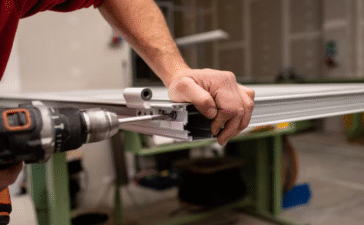A well-organized workshop is the foundation of any successful project, whether it’s a complete car restoration, a custom furniture build, or routine maintenance. While tools and parts are essential, one of the most powerful assets you can have is often overlooked: a detailed garage journal. This log is more than just a notebook; it’s a comprehensive record of your work, a tool for tracking progress, and a roadmap for future endeavors. Many hobbyists and professionals use a workshop project tracking system to manage budgets, monitor tool usage, and document every critical step. If you’ve ever found yourself trying to recall a specific part number or the exact sequence of a complex repair, a car restoration log or a simple DIY project journal can be a game-changer. This guide will walk you through everything you need to know to start and maintain a garage journal that will elevate the quality and efficiency of your work.
What is a Garage Journal?
A garage journal is a systematic record of activities, projects, and maintenance performed in a garage or workshop. Think of it as a diary for your projects. It can be a physical notebook, a digital document, or a specialized app where you log details about your work. For personal use, a garage journal helps DIY enthusiasts keep track of their progress, learn from their mistakes, and replicate successful outcomes. In a professional setting, such as an auto repair shop, a workshop journal serves as an official record of services performed, ensuring consistency, accountability, and a high standard of quality control.
The importance of a garage tracking system cannot be overstated. It provides a structured way to manage complex projects that might span weeks, months, or even years. By documenting every step, you create a reliable reference that helps you stay organized and on schedule. According to a 2023 survey by the Specialty Equipment Market Association (SEMA), the DIY automotive aftermarket is a multi-billion dollar industry, with enthusiasts constantly seeking ways to improve their skills and project outcomes. A well-maintained journal is a key part of that improvement process. Seasoned professionals in the auto industry rely on detailed logs to diagnose recurring issues, train new technicians, and provide clients with transparent, high-quality service, cementing the journal’s role as a cornerstone of expert craftsmanship.
How to Start Your Garage Journal
Starting a garage journal log is a straightforward process that pays long-term dividends. The first step is to choose your preferred format. Some people prefer the tactile feel of a sturdy, spiral-bound notebook, while others opt for the flexibility of digital tools like a spreadsheet or a dedicated garage journal app. There is no right or wrong choice; the best tool is the one you will use consistently.
Once you have your notebook or digital file, it’s time to make your first entry. Begin by creating a title page or a table of contents to help you navigate your projects later. For your first project entry, record the date, a clear project name (e.g., “1969 Camaro Brake System Overhaul”), and an overview of your goals. List the primary tools and materials you anticipate needing. To maintain consistency, make a habit of updating your journal at the end of each work session. Document the date, the specific tasks you completed, any challenges you encountered, and the solutions you found. This habit of daily or session-based logging is crucial for creating a useful workshop log. As a best practice, use clear and concise language. Future you will appreciate not having to decipher cryptic notes. Organizing your entries with consistent headings and sections will also make your journal a valuable and easy-to-use resource for years to come.
Essential Components of a Garage Journal
A truly effective garage journal is well-structured and contains all the necessary information to be a useful reference. While you can customize it to your needs, a good garage journal template should include several core sections. Start every entry with the Project Title and Date to establish a clear timeline. The most critical part of your journal is the Step-by-Step Process, where you document each action you take in detail. This section should be specific enough that someone else (or you, months later) could understand and replicate the work.
Equally important is a section for Tools, Materials, and Costs. Tracking what you use and what you spend helps with budgeting for future projects and managing your inventory. Another key component is Time Management. Log the duration of each task and note key milestones. This helps you estimate timelines for future projects more accurately. Finally, include a section for Outcomes and Adjustments. Here, you can record the results of your work, note any deviations from your original plan, and reflect on what you learned. Professionals often use their workshop log sections to track equipment performance, noting when a tool was calibrated or serviced, and conduct cost-benefit analyses on different parts or materials, turning the journal into a powerful analytical tool.
Tools and Apps for Digital Garage Journals
While a classic paper notebook is effective, digital garage journal tools offer powerful features that can enhance your project tracking. Apps like Evernote or OneNote allow you to create detailed notes, embed photos and videos, and sync your journal across multiple devices. Simple tools like Google Docs or Microsoft Excel spreadsheets can also be customized to create a robust digital garage log. These are great because they are easily searchable, making it simple to find specific information from past projects.
There are also specialized apps designed specifically for enthusiasts, such as GaragePro or AutoLog. These platforms often come with pre-built templates for tracking maintenance, modifications, and expenses, along with features for VIN scanning and service reminders. The primary advantage of a digital journal is its searchability and multimedia capabilities. You can instantly find every time you worked on a specific system or view a photo of a complex wiring setup. However, paper journals have their own charm; they don’t require batteries, are immune to software crashes, and can feel more personal. The choice between a digital or paper workshop tracking tool ultimately depends on your personal preference and workflow.
Real-Life Examples: Garage Journal in Action
To understand the practical impact of a garage journal, let’s look at a couple of examples. Consider a professional mechanic restoring a classic Ford Mustang. They use a detailed car restoration journal to document every step, from engine disassembly to the final paint job. They take photos of part numbers, diagram complex wiring, and log the torque specifications for every bolt. When a custom part doesn’t fit correctly, they note the modifications required. This real garage project log not only ensures the restoration is accurate and high-quality but also serves as a valuable record for the vehicle’s owner, increasing its provenance and value.
Now, imagine a DIY enthusiast building a custom workbench for their garage. They use a simple DIY workshop journal to sketch out their design, create a list of materials, and track their expenses. As they build, they note which joints worked best and what adjustments they had to make to their original plan. When a friend asks for advice on building a similar bench, they can share their detailed log, providing a proven roadmap. An expert from a leading automotive restoration shop once said, “Our journals are our most valuable tool. They are the collective memory of our shop, saving us thousands of hours and preventing countless mistakes. A project’s quality is directly tied to the quality of its log.”
Common Mistakes to Avoid in Garage Journaling
While starting a garage journal is easy, maintaining an effective one requires discipline. One of the most common garage journal mistakes is overcomplication. It can be tempting to document every single minute detail, but this can lead to burnout. Focus on what is truly important: the steps taken, the parts used, and the problems solved. The goal is to create a useful resource, not a literary masterpiece.
Another major pitfall is inconsistency. A journal that is only updated sporadically loses much of its value. Make logging your progress a part of your cleanup routine at the end of each session. A few minutes of documentation while the details are fresh in your mind is far more effective than trying to recall everything weeks later. Also, avoid cluttering your journal with irrelevant entries. Stick to project-related information. If you want to jot down random ideas, keep a separate notebook. These workshop log tips will help ensure your journal remains a clean, focused, and powerful tool for your projects.
Benefits of a Well-Kept Garage Journal
The advantages of keeping a detailed garage journal extend far beyond simple record-keeping. The most immediate benefit is an improved workflow. A journal forces you to think systematically, plan your steps, and work more deliberately, which leads to more organized and efficient operations. It acts as your guide, keeping you on track and minimizing wasted time and effort.
A garage journal is also an invaluable tool for tracking project progress. By reviewing your entries, you can easily identify bottlenecks in your process, see where you are spending the most time, and find areas for improvement. This analytical insight is crucial for both personal skill development and professional efficiency. In the long term, a collection of detailed journals becomes a priceless library of your experience. You can refer back to past projects to solve new problems, share your knowledge with others, and build a portfolio of your work. The workshop log advantages are clear: it saves you time, money, and frustration, making every project more rewarding.
Where to Share Your Garage Journal
One of the most exciting aspects of working on projects is sharing your passion with a like-minded community. Platforms like The Garage Journal forum are dedicated spaces where enthusiasts and professionals share their work, exchange ideas, and offer advice. Sharing your garage project log on such a forum can provide you with expert feedback that can enhance your project and expand your skills.
When you document and share your journey, you not only get help but also contribute to a collective pool of knowledge. Others can learn from your successes and your challenges. You might post updates from your car restoration journal, showing before-and-after photos and explaining the techniques you used. This kind of workshop log sharing fosters a sense of community and can be incredibly motivating. Receiving encouragement and seeing what others are working on can inspire you to tackle more ambitious projects and push your abilities to the next level.
You would also like: “2 car garage dimensions“
Your Next Step: Start Your Journal
Keeping a garage journal is one of the most impactful habits you can adopt to improve your work in the workshop. It transforms chaotic projects into structured, manageable tasks. It serves as your memory, your teacher, and your guide. By documenting your process, you not only ensure better outcomes but also create a valuable record of your skills and accomplishments. Whether you are a weekend DIYer or a seasoned professional, the discipline of maintaining a detailed log will elevate your craft. Don’t wait for your next big project to get started. Grab a notebook or open a new digital file and begin your garage project tracking today. The path to becoming a more skilled and organized creator starts with that first entry.
Frequently Asked Questions (FAQs)
What is a garage journal?
A garage journal is a detailed log used to document projects, maintenance, and other activities in a garage or workshop. It can be a physical notebook or a digital file and is used to track progress, record specifications, manage budgets, and document processes for personal hobbies or professional work.
How do I start a garage journal for my car restoration project?
Begin by choosing a format (notebook or digital app). Title your project (e.g., “1967 Mustang Restoration”) and date your first entry. Outline your project goals, list the initial tools and parts needed, and start documenting every step you take, including photos. Update it regularly after each work session.
Can I keep a digital garage journal?
Yes, absolutely. Digital tools like Evernote, Google Docs, or specialized apps like GaragePro are excellent for keeping a garage journal. They offer benefits such as easy searching, cloud backup, and the ability to include multimedia like photos and videos directly in your entries.
What specific tools and costs should I track in my garage journal?
You should track all consumable materials (e.g., oil, sandpaper, paint), all new parts purchased, and any specialized tools you had to buy or rent for the project. Record the date of purchase, the supplier, and the cost for each item to manage your budget effectively.
Is it better to use a paper or digital journal for garage projects?
Neither is definitively better; it depends on your personal preference. Paper journals are simple, durable, and don’t require power. Digital journals are searchable, can be backed up, and allow for multimedia integration. Try both and see which one you are more likely to use consistently.
What information is essential for a DIY project log?
For a DIY project log, you should include the project name, start and end dates, a sketch or plan, a list of materials with costs, a step-by-step description of your process, any challenges encountered, and photos of the finished product.
How can a garage journal help me save money?
By tracking material and part costs, you can create accurate budgets for future projects. It also helps you remember specific part numbers or suppliers, preventing you from buying the wrong item. Documenting repairs also stops you from performing redundant work.
What is the “Garage Journal” forum?
The Garage Journal forum is a popular online community where thousands of tool and garage enthusiasts share their projects, workshop setups, and knowledge. It’s a great place to get feedback, ask for advice, and see what other people are working on.
How detailed should my garage journal entries be?
Your entries should be detailed enough for you to understand what you did when you look back months or years later. Include key measurements, part numbers, torque specs, and any specific techniques used. Avoid being so detailed that it becomes a chore, but don’t be so brief that the entry is unhelpful.
How often should I update my workshop journal?
It’s best to update your journal at the end of every work session. The details will be fresh in your mind, ensuring accuracy. Making it a consistent habit is the key to maintaining a valuable and effective journal.












